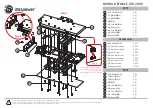
34
ASUS PCI-SIU2 User’s Manual
/X /x
This option is used to exclude particular SCSI drives. Excluded
SCSI drives are identified by specifying the host adapter, target
id and lun. These values are spereated by a colon. Groups of
SCSI drives (or wild cards) can also be identified. Below are
examples of the different ways SCSI drives can be excluded:
/X0:1:2
This will exclude the drive on Host Adapter 0, with target ID 1
and lun 2.
/X0:2
This will exclude the drive on Host Adapter 0, with target ID 2
and ANY lun
/X0
This will exclude ALL drives on Host Adapter 0.
SAMPLE CONFIG.SYS
These samples assume that the user has loaded the ASUS drivers in the follow-
ing directory: c:\iniaspi.
Config.sys:
DEVICEHIGH=c:\iniaspi\aspia100.sys
DEVICEHIGH=c:\iniaspi\inicd.sys /R2
Explanation:
The first line loads the ASPI manager and the second line loads the SCSI disk
driver specifying that a minimum of two drive letters be reserved for each MO
and removable disk attached to the SCSI bus.
ASPI Partition & Format Utility
INIFDISK.EXE is a DOS ASPI partition and format utility. It requires the
ASPIA100.SYS and INIDISK.SYS drivers to be loaded in order for it to func-
tion properly. INIFDISK.EXE is installed by the ASUS DOSSETUP or SETUP
programs. Upon invocation, the initial screen will have two windows. The top
window will list all of the SCSI devices installed in the system. The user can
highlight a particular device by using the up and down arrow keys. The bot-
tom window will display information about the device that is currently high-
lighted in the top window. Inifdisk.exe can partition and format any SCSI
storage device that is not being controlled by the BIOS, this includes SCSI
disks, magnetic optical drives, and removable media devices. INIFDISK will
display two screens in which the bottom portion will explain all commands
possible in the top window.
5. MS-DOS Driver Installation
















































